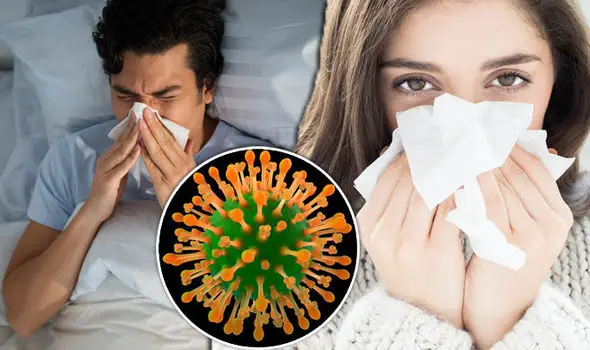Flu Symptoms 2018 In Adults, Kids And Even Dogs – The Signs And What They Mean

Flu comes suddenly, causing mild to severe ailments, and, at times, leading to death. Therefore, it must not be taken lightly.
So here are the symptoms of the contagion viral and some dos and don'ts to stay safe from this neglected but dangerous disease!
Flu Symptoms in Adults:
The flu or influenza virus is generally passed from person to person through the air. This means adults and children can contract the virus through contact with an infected person.

One of the symptoms of flu, running nose (Photo: express.co.uk)
Many people who contract the flu recover within days to two weeks.
One or all of the following symptoms are visible in people infected with the flu virus:
- cough
- sore throat
- runny or stuffy nose
- muscle or body aches
- headaches
- fatigue (tiredness)
- some people may have vomiting and diarrhea, though this is more common in children than adults.
- fever or feeling feverish/chills though not everyone with flu gets a fever.
Although affected people can get feverish, they will not necessarily have fever as in the case of common cold.
Dire Warning Signs Of Flu Sickness:
In some people, the flu can aggravate the condition leading to the following symptoms:
- difficulty in breathing or shortness of breath
- pain or pressure in the chest or abdomen
- sudden dizziness
- confusion
- severe or persistent vomiting
- flu-like symptoms that improve but then return with fever and worse cough
These symptoms can lead to further aggravation and complications related to the disease.
Complications Arising from Flu:
Normally, people who have flu recover within days to two weeks. But flu can trigger some life-threatening complications, like:
- pneumonia
- bronchitis
- sinus
- ear infections
The flu can worsen chronic health problems in people with, for example, asthma and congestive heart disease leading to death as well.
Treatment:
In addition to the flu shot, the following are the best measures to contain spread and control of the disease:
- stay at home and rest
- avoid close contact with others
- drink plenty of fluids
- treat the fever with over-the-counter medicines
- call your healthcare provider in severe cases
- see a health care provider for vaccine guidance
Plenty of rest, fluids and avoidance of contact are the best ways in addition to a flu shot for convalescence.
Flu Symptoms in Kids:
Children under five are at high risks, and those under two are at the highest risk of developing severe complications due to the flu because the children's immune systems are still in developmental stages.
The symptoms of the flu in children and infants include:
- fever, which may be as high as 103° F (39.4° C) to 105° F (40.5° C)
- body aches, including muscle and joint
- headaches
- sore throat
- runny or stuffy nose
- worsening cough
- nausea
- vomiting
- diarrhea
- fatigue
- secondary ear and sinus infections
- secondary pneumonia
The symptoms are more or less the same in children and infants as in adults, but flu in children causes at least two or three above-mentioned symptoms.
Emergency Warning Signs Of Flu Sickness
In critical cases, the following symptoms will show in children and infants.
- fast or troubled breathing
- bluish skin color
- lack of interest in drinking enough fluids
- not waking up or not interacting
- being so irritable that the child does not want to be held
- flu-like symptoms improve but then return with fever and worse, cough
- fever with a rash
Additionally, the following signs can appear in severe cases in infants:
- inability to eat
- troubled breathing
- no tears when crying
- significantly fewer wet diapers than normal
It is important to look out for these symptoms and act fast for proper diagnosis.
People at High Risk from Flu
Anyone can contract flu, including healthy people at any age. But the following are prone to high risk from flu-related problems:
- people above 65 years
- pregnant women
- young children
- anyone with chronic medical conditions such as asthma, diabetes, or heart disease
Special care needs to be taken for these high-risk people to ensure that they do not develop life-threatening complications that can even lead to death.
Remedy:
Although CDC(Centers for Disease Control and Prevention) has warned that the flu shot has been less efficient, they still recommend getting it as it can diminish the severity of symptoms in the eventuality of catching it.

A child gets a flu shot (slate.com)
Here are the other few steps that can be taken:
- vaccine
- frequent hand-washing
- avoiding contact with sick people
- avoiding touching your eyes, nose, and mouth
- disinfecting surfaces.
These precautionary measures will help in keeping the patients as safe as possible.
Flu Symptoms in Dogs:
Even pets are not safe from the flu. Dogs, too, suffer from two forms of flu; however, animals to human transmission do not occur.

A dog and its pup convalesce from flu by taking rest (Photo: barkpost.com)
In eighty percent of dogs exposed to the virus, symptoms are visible within one to five days. The remaining 20 percent show no signs, whatsoever.
Mild flu symptoms:
These are some of the symptoms of the mild flu:
- soft cough lasting up to a month
- lethargic and down
- increase eyes and nasal discharge
- sneezing
In addition to these, the following symptoms occur in severe cases.
Severe Flu Symptoms:
Critical symptoms in dogs include:
- high fever
- pneumonia
- trouble breathing
- dependent on supplemental oxygen
These symptoms warrant urgent consultation with the veterinary doctors.
Treatment:
There is no cure for dog flu. Most recover within two to three weeks; however, the following can speed up the recovery process:
- keep dogs hydrated
- keep them well-fed
- keep them comfortable
- give them rest
Veterinarians may also offer supportive care, such as providing medicine administering fluids and prescribing antibiotics to treat any secondary bacterial infections.
Precautions against spreading and relapse:
The following precautions need to be taken to keep your pets safe from the flu:
- keep them separate from susceptible animals for three to four weeks after recovery
- don't allow them to sniff another pup on the street
- protect them from exposure to barking, coughing and sneezing
- disinfect water bowls, toys, food, clothing, shoes, and leashes, etc. as they may harbor the virus
It is important that these precautions are adhered to keep your dogs flu-free.
Before the onset of the flu season, it is advisable to contact the health service provider or your personal physician for consultation. While in doubt, it is always better to reach out to health clinics as soon as possible without waiting for the symptoms. This applies to dogs as well.